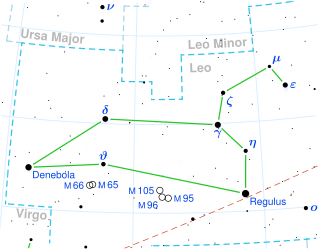 2MASS 0937+2931 Credit: legacy surveys | |
| Observation data Epoch J2000 Equinox J2000 | |
|---|---|
| Constellation | Leo |
| Right ascension | 09 37 34.9 |
| Declination | 29° 31′ 41″ |
| Characteristics | |
| Spectral type | T6p |
| Astrometry | |
| Proper motion (μ) | RA: 944.15 ± 1.24 mas/yr Dec.: −1319.78 ± 1.21 mas/yr |
| Parallax (π) | 163.39 ± 1.76 mas |
| Distance | 20.0 ± 0.2 ly (6.12 ± 0.07 pc) |
| Details | |
| Mass | 41.56±25.72 MJup |
| Radius | 0.94±0.16 RJup |
| Luminosity | 0.000005 L☉ |
| Surface gravity (log g) | 4.97±0.48 cgs |
| Temperature | 881±74 K |
| Age | 0.5-10 Gyr |
| Other designations | |
| 2MASS J09373487+2931409 2MASSI J0937347+293142 2MASS 0937+2931 | |
| Database references | |
| SIMBAD | data |
 | |
2MASS J09373487+2931409, or 2MASSI J0937347+293142 (abbreviated to 2MASS 0937+2931) is a brown dwarf of spectral class T6, located in the constellation Leo about 19.96 light-years from Earth.
Discovery
2MASS 0937+2931 was discovered in 2002 by Adam J. Burgasser et al. from Two Micron All-Sky Survey (2MASS), conducted from 1997 to 2001. Follow-up observations were made in 1998–2001 using the Near-Infrared Camera, mounted on the Palomar 60 inch (1.5 m) Telescope; CTIO Infrared Imager (CIRIM) and Ohio State Infrared Imager/Spectrometer (OSIRIS), mounted on the Cerro Tololo Inter-American Observatory (CTIO) 1.5 m Telescope; and some additional observations were made using the Near Infrared Camera (NIRC), mounted on the Keck I 10 m telescope, and nearinfrared camera D78, mounted on the Palomar 5 m Hale Telescope. In 2002 Burgasser et al. published a paper, where they defined new spectral subtypes T1—T8, and presented discovery of 11 new T-type brown dwarfs, among which also was 2MASS 0937+2931. This 11 objects were among the earliest T-type brown dwarfs ever discovered: before this, the total number of known T-type objects was 13, and this discoveries increased it up to 24 (apart from additional T-type dwarfs, identified by Geballe et al. 2001 in SDSS data).
Distance
Currently the most precise distance estimate of 2MASS 0937+2931 is trigonometric parallax, published in 2009 by Schilbach et al.: 163.39 ± 1.76 mas, corresponding to a distance 6.12 ± 0.07 pc, or 19.96 ± 0.22 ly. A less precise parallax of this object, measured under U.S. Naval Observatory Infrared Astrometry Program, was published in 2004 by Vrba et al.
Properties
2MASS 0937+2931 has an unusual spectrum, indicating a metal-poor atmosphere and/or a high surface gravity (high pressure at the surface). Its effective temperature is estimated at 800 Kelvin. The Research Consortium On Nearby Stars (RECONS) estimates the brown dwarf to be 0.03 solar masses. No optical variability was detected as in 2014.
See also
The other 10 brown dwarfs, presented in Burgasser et al. (2002):
- 2MASS 0243-2453 (T6)
- 2MASS 0415-0935 (T8)
- 2MASS 0727+1710 (T7)
- List of stars in Leo
References
- ^ Schilbach, E.; Röser, S.; Scholz, R.-D. (2009). "Trigonometric parallaxes of ten ultracool subdwarfs". Astronomy and Astrophysics. 493 (2): L27 – L30. arXiv:0811.4136. Bibcode:2009A&A...493L..27S. doi:10.1051/0004-6361:200811281. S2CID 17774863.
- ^ Filippazzo, Joseph C.; Rice, Emily L.; Faherty, Jacqueline; Cruz, Kelle L.; Van Gordon, Mollie M.; Looper, Dagny L. (2015), "Fundamental Parameters and Spectral Energy Distributions of Young and Field Age Objects with Masses Spanning the Stellar to Planetary Regime", The Astrophysical Journal, 810 (2): 158, arXiv:1508.01767, Bibcode:2015ApJ...810..158F, doi:10.1088/0004-637X/810/2/158, S2CID 89611607
- ^ Burgasser, Adam J.; Kirkpatrick, J. Davy; Brown, Michael E.; Reid, I. Neill; Burrows, Adam; Liebert, James; Matthews, Keith; Gizis, John E.; Dahn, Conard C.; Monet, David G.; Cutri, Roc M.; Skrutskie, Michael F. (2002). "The Spectra of T Dwarfs. I. Near-Infrared Data and Spectral Classification". The Astrophysical Journal. 564 (1): 421–451. arXiv:astro-ph/0108452. Bibcode:2002ApJ...564..421B. doi:10.1086/324033. S2CID 9273465.
- "2MASS J09373487+2931409 -- Brown Dwarf (M<0.08solMass)". SIMBAD. Centre de Données astronomiques de Strasbourg. Retrieved 2012-11-26.
- Vrba, F. J.; Henden, A. A.; Luginbuhl, C. B.; Guetter, H. H.; Munn, J. A.; Canzian, B.; Burgasser, Adam J.; Kirkpatrick, J. Davy; Fan, X.; Geballe, T. R.; Golimowski, D. A.; Knapp, G. R.; Leggett, S. K.; Schneider, D. P.; Brinkmann, J. (2004). "Preliminary Parallaxes of 40 L and T Dwarfs from the US Naval Observatory Infrared Astrometry Program". The Astronomical Journal. 127 (5): 2948–2968. arXiv:astro-ph/0402272. Bibcode:2004AJ....127.2948V. doi:10.1086/383554. S2CID 16344176.
- "The 100 nearest star systems". Research Consortium on Nearby Stars. Georgia State University. January 1, 2012. Retrieved 2012-06-11.
- Heinze, Aren N.; Metchev, Stanimir; Kellogg, Kendra (2014), "Weather on Other Worlds. III. A Survey for T Dwarfs with High-Amplitude Optical Variability", The Astrophysical Journal, 801 (2): 104, arXiv:1412.6733, doi:10.1088/0004-637X/801/2/104, S2CID 119217978
External links
- Burgasser et al.: A Method for Determining the Physical Properties of the Coldest Known Brown Dwarfs"; in: The Astrophysical Journal, Vol. 639, Issue 2, S. 1095ff. (2006)
- Cushing et al.: A Spitzer Infrared Spectrograph Spectral Sequence of M, L, and T Dwarfs"; in: The Astrophysical Journal, Vol. 648, Issue 1, S. 614ff. (2006)
| Known celestial objects within 20 light-years | |||||||||||||||||||||||||||||||||||||||||||
|---|---|---|---|---|---|---|---|---|---|---|---|---|---|---|---|---|---|---|---|---|---|---|---|---|---|---|---|---|---|---|---|---|---|---|---|---|---|---|---|---|---|---|---|
| |||||||||||||||||||||||||||||||||||||||||||
| |||||||||||||||||||||||||||||||||||||||||||
| |||||||||||||||||||||||||||||||||||||||||||
| |||||||||||||||||||||||||||||||||||||||||||
| Italic are systems without known trigonometric parallax. | |||||||||||||||||||||||||||||||||||||||||||
| Constellation of Leo | |||||||||||||
|---|---|---|---|---|---|---|---|---|---|---|---|---|---|
| Stars |
| ||||||||||||
| |||||||||||||
| Galaxies |
| ||||||||||||